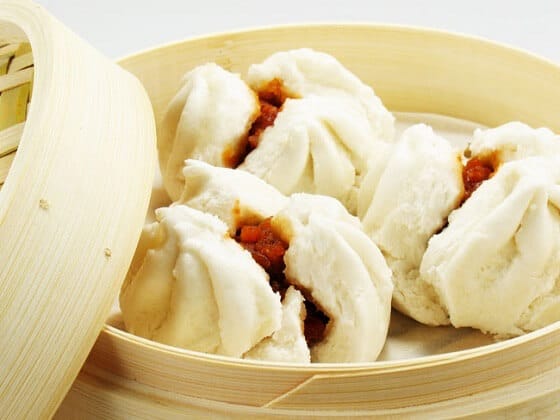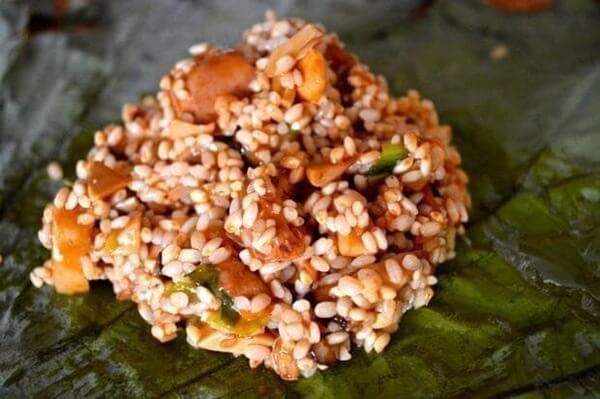In Vietnam, dim sum has quickly become a popular dish due to its rich flavors and communal dining atmosphere. Vietnamese dim sum is a unique blend of Chinese and Vietnamese culinary traditions, resulting in a delectable eating experience that should not be missed.
In this post, we’ll delve into the roots of dim sum in China and how it has evolved into Vietnamese dim sum, a delicious fusion of two culinary traditions. We’ll also offer suggestions on how to enjoy dim sum like a local and discover the best spots to savor this mouth-watering cuisine in Vietnam.
See more: Exploring the Vibrant Culinary Adventure of Vietnamese Cuisine
Contents
Exploring the Delicious Vietnamese Dim Sum Scene
Dim sum, which means “to touch the heart” in Cantonese, is a popular cuisine that originated in Guangdong region in southern China. Small, bite-sized quantities of savory or sweet meals are served in steamer baskets or on small plates in this dining style. Dim sum is traditionally eaten for breakfast or lunch and is served in numerous rounds with tea.
Dim sum is becoming a popular meal worldwide, including in Vietnam. Chinese cuisine has profoundly affected Vietnamese cuisine, and dim sum has become a staple meal item in many Vietnamese restaurants. Here are some of the most famous traditional Chinese dim sum available in Vietnam:
- Há cảo (shrimp dumplings): These delicate dumplings are typically filled with a mixture of shrimp and bamboo shoots and are a staple in any dim sum spread. In Vietnam, há cảo is often served with a sweet chili dipping sauce that adds a bit of heat to the dish.

Source: Internet - Xíu mại (pork and shrimp dumplings): These dumplings are similar to há cảo but are filled with a mixture of ground pork and shrimp and are sometimes topped with fish roe. In Vietnam, xíu mại is often served with a soy-based dipping sauce that complements the savory flavors of the dish.

Source: Internet - Xá xíu (barbecued pork buns): These fluffy, steamed buns are filled with sweet and savory barbecued pork and can be found in cooked and baked varieties. In Vietnam, xá xíu is often served with a sweet soy dipping sauce that enhances the pork’s flavors.

Source: Internet - Lo mai gai (sticky rice wrapped in lotus leaf): This dish consists of sticky rice filled with chicken or pork, mushrooms, and Chinese sausage, all wrapped in a lotus leaf and steamed to perfection. In Vietnam, lo mai gai is often served with a soy-based dipping sauce that complements the savory flavors of the dish.

Source: Internet - Cheong fun (rice noodle rolls): These delicate rolls are filled with shrimp, pork, or beef and drizzled with a sweet soy sauce. In Vietnam, Cheong fun is often topped with fried shallots and served with a sweet soy dipping sauce.

Source: Internet
While these dishes are traditionally Chinese, Vietnam has several regional variations and distinctive preparations. Vietnamese-style há cảo, for example, may have a mixture of ground pork, shrimp, and occasionally crab meat and is often served with a sweet chili dipping sauce.
Depending on the establishment, Cheong fun may also be loaded with various foods, such as crispy fried shrimp or barbecued pork. These varieties add complexity and variety to Vietnam’s already lively food landscape.
Discover the essence of Vietnam food as you explore the authentic flavors of the country’s rich and diverse cuisine.
Dim sum has grown in popularity in Vietnam, with many restaurants offering all-you-can-eat dim sum buffets for breakfast and lunch. Locals and tourists enjoy this communal dining experience, and it’s not uncommon to find families and groups of friends gathering around a table, sipping tea, and sharing dim sum delicacies. Whether you’re a dim sum connoisseur or a novice, Vietnam’s dim sum dishes are to be noticed.
Top 6 Steaming Hot Dim Sum Destinations in Vietnam
Vietnam’s love for dim sum has resulted in many restaurants and food stalls serving this beloved cuisine. Here are some of the best places in Vietnam to enjoy authentic dim sum from China, with a focus on Ho Chi Minh City:
- Baozi Restaurant – District 5, Ho Chi Minh City: This restaurant is a local favorite for its delicious and affordable dim sum dishes. The steamed buns are a must-try, ranging from traditional pork and vegetable fillings to more creative options like salted egg yolk and duck. The ambiance is casual and unpretentious, focusing on the food rather than the decor.
- Hai Ky Mi Gia – District 5, Ho Chi Minh City: While this restaurant is primarily known for its noodle dishes, it also serves up some of the best dim sums in the area. The pork and shrimp dumplings stand out, with a juicy and flavorful filling wrapped in delicate skin. The prices are reasonable, and the ambiance is bustling and lively.
- Dim Tu Tac – District 5, Ho Chi Minh City: This restaurant offers a modern and chic dining experience with a focus on fresh and high-quality ingredients. The menu features classic dim sum dishes and more creative options like truffle and mushroom dumplings. Prices are moderate, and the ambiance is upscale and sophisticated.
- Dimsum HongKong – District 2, Ho Chi Minh City: This restaurant is known for its fresh, handmade dim sum, which is made to order. The ambiance is modern and chic, with a spacious and comfortable dining area. Prices are moderate, and the restaurant also offers all-you-can-eat options for those who want to try a variety of dishes.
- Legend Beer Restaurant – Hanoi: With several locations throughout the city, Dimsum Legend is a popular spot for locals and tourists alike. The restaurant offers various dim sum dishes, from traditional staples to unique and creative offerings. Prices are affordable, and the ambiance is casual and laid-back.
- Crystal Jade Kitchen: Many people say that if you haven’t tried dim sum at Crystal Jade Kitchen, you haven’t truly experienced Da Nang. That’s how popular their dim sum is. The restaurant staff is well-trained and professional, from their service etiquette to their attitude toward guests. What’s even more surprising is that despite the luxurious and beautiful space, and the delicious food, the prices are very reasonable.
These restaurants provide a broad range of experiences, from casual and modest to sophisticated and stylish, but they all serve tremendous and authentic dim sum. Vietnam’s dim sum selections are to be noticed, whether you’re seeking a fancy dining experience or a quick lunch from a food stall.
Continue your culinary exploration of Vietnamese cuisine, where the journey extends to the diverse world of Vietnamese bread, offering a delightful taste of the country’s gastronomic richness.
How to Enjoy Dim Sum Like a Vietnamese Local?
In Vietnam, dim sum is more than a meal; it’s a cultural experience best shared with friends and family. Here are some pointers on how to eat dim sum like a true Vietnamese.

- Share plates: Dim sum is traditionally served family-style, with small plates to be shared among the table. Feel free to try some of everything and pass the plates around so everyone can taste it.
- Use chopsticks: While some restaurants may provide utensils like forks and spoons, chopsticks are the traditional way to eat dim sum. If you’re uncomfortable using chopsticks, don’t worry – asking for a fork or spoon is okay.
- Pace yourself: With so many delicious dishes to try, it’s easy to overindulge. Take your time and pace yourself, savoring each bite and enjoying the company of your dining companions.
- Pair with tea: Tea is the traditional beverage to accompany dim sum, as it helps to cleanse the palate between bites. Some popular tea options include jasmine, oolong, and pu-erh. Be bold and ask your server for recommendations.
- Try different sauces: Dim sum is often served with a variety of dipping sauces, including soy sauce, hoisin sauce, and chili sauce. Experiment with different combinations of spices to find your favorite flavor pairings.
- Be mindful of customs: In Vietnamese culture, it’s considered impolite to waste food or leave food on your plate. Try only to take what you can eat, and if you’re full, politely decline additional servings.
By following these tips, you’ll be able to enjoy dim sum like a Vietnamese local and fully appreciate the rich cultural experience that comes with this beloved cuisine.
Experience the diverse taste of Vietnam on a flavorful journey through its culinary delights.
Conclusion
Finally, dim sum has become a popular cuisine in Vietnam, with many restaurants and food carts serving authentic dishes to residents and visitors. There is something for everyone, from traditional pork and shrimp dumplings to more imaginative selections like truffle and mushroom dumplings.


Related Posts
Review Vinh Trang Pagoda: A My Tho Architectural Gem
Nestled in the heart of My Tho City, Vinh Trang Pagoda stands as one of the most magnificent and historically significant religious sites in the Mekong Delta region. This architectural masterpiece, with its unique fusion of Eastern and Western design elements, has captivated visitors for years. As one of the premier My Tho attractions, the […]
10 Best Things To Do In My Tho – Mekong Delta
My Tho, the charming capital of Tien Giang Province, serves as the perfect gateway to the enchanting Mekong Delta region. Located just 70 kilometers southwest of Ho Chi Minh City, this riverside city offers visitors an authentic taste of Vietnamese rural life, where ancient traditions blend seamlessly with modern tourism. When exploring things to do […]
Ho Chi Minh To Mekong Delta: Best Transport Options Guide
The journey from Ho Chi Minh to Mekong Delta offers travelers an exciting transition from Vietnam’s bustling commercial capital to the tranquil waterways and lush landscapes of the country’s agricultural heartland. This comprehensive guide explores all transportation options available for reaching the Mekong Delta, helping you choose the best method based on your budget, time […]